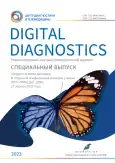Создание оптимизированного калькулятора для качественной оценки риска переломов на фоне остеопороза для населения города Москвы
- Авторы: Артюкова З.Р.1, Кудрявцев Н.Д.1, Икрянников Е.О.1, Титова А.В.1, Балашов М.К.1, Петряйкин А.В.1
-
Учреждения:
- Научно-практический клинический центр диагностики и телемедицинских технологий
- Выпуск: Том 4, № 1S (2023)
- Страницы: 11-13
- Раздел: Материалы конференции
- URL: https://journals.rcsi.science/DD/article/view/147652
- DOI: https://doi.org/10.17816/DD430329
- ID: 147652
Цитировать
Полный текст
Аннотация
Обоснование: для постановки диагноза «остеопороз» (ОП) и оптимизации количества пациентов, которым необходимо выполнить рентгеновскую денситометрию, рекомендован инструмент FRAX — оценка 10-летнего риска переломов. В силу ряда обстоятельств интеграция полноценного инструмента FRAX в цифровые контуры Департамента здравоохранения города Москвы затруднена.
Цель: разработать калькулятор 10-летней вероятности остеопоротических переломов для оптимизации маршрутизации пациентов на обследование.
Методы: для создания оптимизированного калькулятора HF (Half-FRAX) за основу был взят инструмент FRAX от Шеффилдского университета, который разработан на основании результатов популяционных исследований Российский Федерации. В калькулятор оценки риска были включены все данные, отмеченные в оригинальном алгоритме FRAX: пол, возраст, рост, вес, Т-критерий (при наличии), а также другие важные параметры: переломы в анамнезе, переломы бедра у родителей, курение, приём глюкокортикоидов, ревматоидный артрит, вторичный остеопороз, приём алкоголя. Разработан и реализован алгоритм взаимодействия с сайтом FRAX для верификации критических уровней стратификации пациентов путём многократного последовательного перебора различных сочетаний на уровне предела точности измерений: индекса массы тела (ИМТ) (дискретизация 0,1) и возраста (дискретизация 1 год). За пороговые значения приняты данные, полученные из клинических рекомендаций.
Результаты: при реализации разработанного алгоритма путём моделирования различных сочетаний ИМТ, Т-критерия и факторов риска (ФР) показано, что отсутствие у женщин ФР, ИМТ более 25 (верхняя граница нормы) гарантированно исключают попадание в «оранжевую зону», где необходимо выполнение денситометрии. Показано, что у мужчин ИМТ не являлся ФР. В случае наличия ФР формируется рекомендация: «Пациенту следует обратиться к специалисту». При отсутствии Т-критерия, но выявлении ФР — «Пациенту показано проведение денситометрии». Аналогичные результаты были и в заключении для женщин при тех же показателях. При отсутствии ФР и Т-критерии более (–2,5) указывается «низкий фактор риска перелома» как для мужчин, так и для женщин.
Заключение: разработан оптимизированный калькулятор 10-летней вероятности основных переломов при ОП HF (Half-FRAX), который позволит оптимизировать маршрутизацию пациентов для проведения денситометрических исследований, что в свою очередь сократит нагрузку на отделения лучевой диагностики в г. Москве и в то же время позволит своевременно направить пациентов на консультацию к соответствующим клиническим специалистам. Half-FRAX интегрирован в цифровую платформу «Остеопороз» (https://telemedai.ru/cifrovaya-platforma-osteoporoz/half-frax).
Ключевые слова
Полный текст
Открыть статью на сайте журналаОб авторах
Злата Романовна Артюкова
Научно-практический клинический центр диагностики и телемедицинских технологий
Автор, ответственный за переписку.
Email: zl.artyukova@gmail.com
ORCID iD: 0000-0003-2960-9787
SPIN-код: 7550-2441
Россия, Москва
Никита Дмитриевич Кудрявцев
Научно-практический клинический центр диагностики и телемедицинских технологий
Email: KudryavtsevND@zdrav.mos.ru
ORCID iD: 0000-0003-4203-0630
SPIN-код: 1125-8637
Россия, Москва
Егор Олегович Икрянников
Научно-практический клинический центр диагностики и телемедицинских технологий
Email: ikriannikove01@gmail.com
ORCID iD: 0000-0002-1780-6903
Россия, Москва
Анна Владимировна Титова
Научно-практический клинический центр диагностики и телемедицинских технологий
Email: TitovaAV3@zdrav.mos.ru
ORCID iD: 0009-0002-1136-9906
Россия, Москва
Максим Константинович Балашов
Научно-практический клинический центр диагностики и телемедицинских технологий
Email: BalashovMK@zdrav.mos.ru
ORCID iD: 0000-0002-1811-874X
Россия, Москва
Алексей Владимирович Петряйкин
Научно-практический клинический центр диагностики и телемедицинских технологий
Email: alexeypetraikin@gmail.com
ORCID iD: 0000-0003-1694-4682
Россия, Москва
Список литературы
- Белая Ж.Е., Белова К.Ю., Бирюкова Е.В., и др. Клинические рекомендации: Остеопороз. Москва; 2021. С. 105. Доступ по ссылке: https://cr.minzdrav.gov.ru/schema/87_4
Дополнительные файлы









